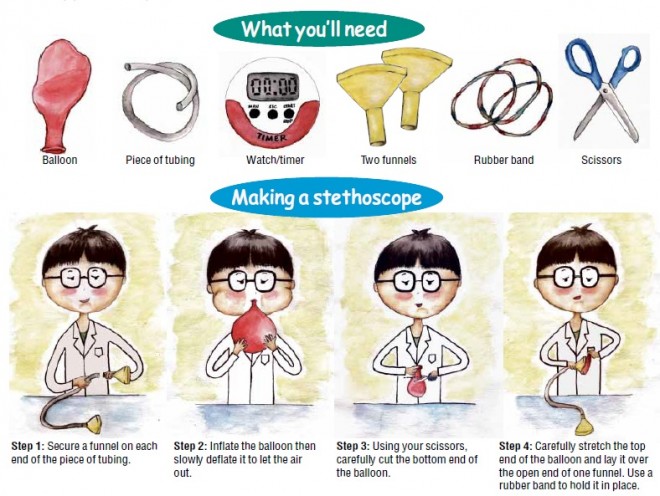The Heartbeat
The average adult heart beats 72 times per minute, 4,320 times per hour, 103,680 times per day, 37,843,200 times per year and 2,838,240,000 times in an average lifetime (37,843,200 beats per year x 75).
The heart is one of the most important organs in the human body. It is actually a muscle that continuously pumps blood to all parts of our body through blood vessels.
Blood moves through open spaces within the heart. The heart throbs to push blood throughout the entire body, first through the brain, then through the arteries and on to the other organs of the body. The blood then travels back to the heart through the veins.
THE EXPERIMENT
When you see a doctor, he or she usually checks first your heartbeat. To do this, he or she uses a stethoscope.
Today, you will make your own stethoscope and use it to listen to another person’s heartbeat.
Counting heartbeats
Place the funnel covered by the balloon over the area. Carefully place the other funnel to your ear and wait for a beating sound.
Count all the “beats” in 30 seconds then multiply the number by two.
The resulting number is your heartbeat in one full minute. If the beating is irregular, however, count to one full minute.
THE SCIENCE
Lub-dub, lub-dub, lub-dub!
We know that the heart is responsible for receiving blood from the system and ejecting blood into the system. But the heart does not provide the needed oxygen. Instead, the heart works with the lungs to again supply oxygen to the blood. The heart receives the low-oxygen blood then pushes it into the lungs for reoxygenation.
So, how is this connected to heart sounds? Well, because of these heart sounds, we can track this internal process.
The heart has two sounds: the “lub,” or S1, and the “dub,” or S2.
The “lub” is the sound made by the closure of two valves: the tricuspid and mitral valves. The heart receives the blood from the system. The “lub” is created after the top two heart chambers have finished emptying blood down into the lower ventricles. These two valves shut off, preventing the backflow of blood into the two top chambers, thus creating the “lub” sound.
The “dub” sound is made by the closure of two other valves: the pulmonic (or pulmonary) and aortic valves. The “dub” sound is the shutting sound of both the pulmonic and aortic valves, preventing the backflow of blood into the heart.
In our experiment, you can hear these sounds because of the vibration caused by the closing valves on the stretched balloon. The vibration is then transmitted through the tube and carried to your ear as sound vibrations.
Takeaway learning
It is important to your health that you take good care of your heart. At an early age, make it a habit to eat healthy food and to exercise regularly by playing sports or by simply walking or running. It is also important to make smart choices as you grow older, avoiding activities such as smoking, which can damage your heart. Love your heart and your heart will love you for it!
Using the newspaper
Look in the Inquirer for compound words and idiomatic expressions that have the word “heart” in them. Make a list of these words, look in the dictionary for their meanings and use each in a sentence.
Examples:
Heartburn: An unpleasant, hot feeling in your chest caused by something that you ate
Going to bed right after eating supper causes heartburn.
Heart-to-heart: Sincere and frank
My brother changed after our very sick father had a heart-to-heart talk with him.
Not for the faint of heart: Something not for those lacking courage
Boxing is not for the faint of heart.
Next Tuesday: Lung Power Experiment
About the series
The joy of discovery. The fun of learning.
These are the experiences that Bayer wants to pass on to young people in keeping with its mission, “Bayer: Science for a Better Life,” and its enthusiasm for research.
By putting together simple, educational and fun experiments, elementary school students are encouraged to learn Science by doing Science.
The Bayer Smiling Kiddie Einsteins series offers teachers, parents and students hands-on and inquiry-based experiences that involve observing, experimenting, hypothesizing, analyzing and testing.
Through this series of experiments related to health, agriculture-
nutrition and hi-tech materials, Bayer and Inquirer in Education aim to deepen the interest of elementary pupils in Science.
The materials needed for these experiments are safe and can easily be accessed from your homes.



